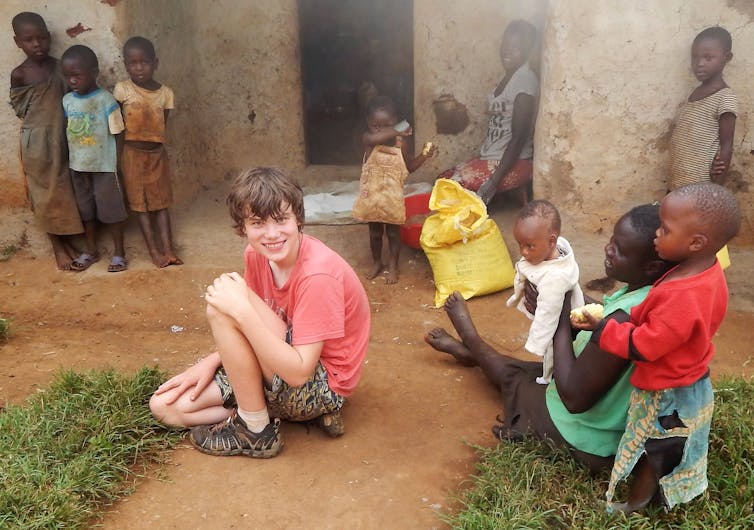
Last night’s ABC Australian Story episode featuring Sam and James Best’s journey through Africa illustrates the lengths parents will go to in supporting their children on the autism spectrum to reach their full potential.
Clearly, Africa is not the practical answer to helping the majority of children thrive. But the lessons learnt from the journey may encourage a slightly “riskier” approach to parenting and education for some children with autism.
An unconventional approach
Parents James and Benison decided to take Sam to Africa for six months to “expose him to a prolonged period of uncertainty and unpredictability” to increase Sam’s social communication and independent living skills. This was despite the fact that insistence on sameness, inflexible adherence to routines, and ritualised patterns of behaviour are hallmarks of autism.
So the parents’ approach contrasts with that of some educational interventions, such as structured teaching that aims to provide predictability and routine to students on the autism spectrum. Structured teaching has emerging research evidence and has been described as “one of the key ‘tools’ in autism education”.
But is providing predictability and routine to someone who appears to desire that environment the best way to promote independence for all children?
James and Benison are not the first people to suggest that mixing up the environment may help young people on the autism spectrum learn to adapt. In fact, engineering the environment to create opportunities for children to engage with others, and then gradually expanding their skills, interests, and attention is a key component of Naturalistic Developmental Behavioural Interventions. This is an evidence-based approach for young children with autism.

Sam Best with village kids. Australia Story/ABC
James and Benison are not the first parents to embark on a journey of this type. But the approach they took is one of the most intensively-documented and ground- breaking in the sense that research was embedded in it. Sam’s parents agreed to participate in interviews, collect video footage of Sam interacting with James and strangers along the journey, and complete a questionnaire assessing changes in Sam’s participation in daily activities.
Did it work?
A case study is not designed to tell us if the journey worked. Instead, it aims to provide insights and provoke new thinking. Sam’s parents described a broadening of his skill base, his resilience, his prolonged reciprocal conversation, a worldliness and sophistication, and his self-belief following the journey. They did not report any negative side effects, and commented that family friends and teachers noticed positive changes in Sam.
Our preliminary analysis, based on videos and a questionnaire collected at the start and end of the journey, indicates it was associated with positive changes in Sam’s social communication and independent living skills. We are finalising our analyses ahead of submitting to a research journal for peer review. However, the main contribution of this work will lie in the possible lessons to be learnt.
What can we learn?
This is not a new intervention for autism, as James readily agrees. A range of effective approaches are available and these should continue be the focus of parents’ and professionals’ efforts to promote children’s social communication and independent living skills.

James and Sam Best on bank of Nile River. Australian Story/ABC
When I interviewed James and Benison for the study, they credited previous intervention programs for equipping them with the skills and confidence to support Sam’s development. As James explained:
[Early intervention] was our training ground, so this is the extension of that.
However, the findings highlight the potential value of carefully creating more risks in young people’s lives, and helping them navigate these to greater independence. Africa exposed Sam and James to multiple risks associated with possible illness, accidents, and misadventure.
It was also possible that gains Sam had been making at school would diminish during the absence from school. As James remarked:
There were big risks and they were risks that were bigger than travelling with a 14-year-old without autism by quite a long way.
He suggested instead other parents build multiple smaller risks into everyday life to promote their children’s independence.
Push yourself to say look let’s give him a paper run, let’s get him to join this club and participate, the Scouts or whatever it is. Let’s give him responsibilities and tasks that you may fail at that are not necessarily likely to result in some great danger. Let’s send him to the corner shop.
The findings also highlight the power of parents being at the centre of efforts to promote their children’s development. It appears that intensive, father-son contact during this journey was a key factor in the perceived success. James could balance the initial cognitive, sensory, and communication challenges of the highly dynamic African context and gradually reduce these over time. Prior to the journey he said:
I’m hoping at the beginning that I’ll be taking him, and by the end that he’s taking me.
The responsibility sits with government, employers, family and friends to create time and space for all parents to support their children to thrive, including those with young people on the autism spectrum.
![]()
David Trembath receives funding from the National Health and Medical Research Council (GNT1071811).
